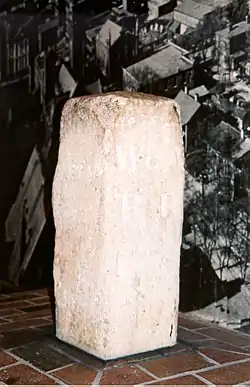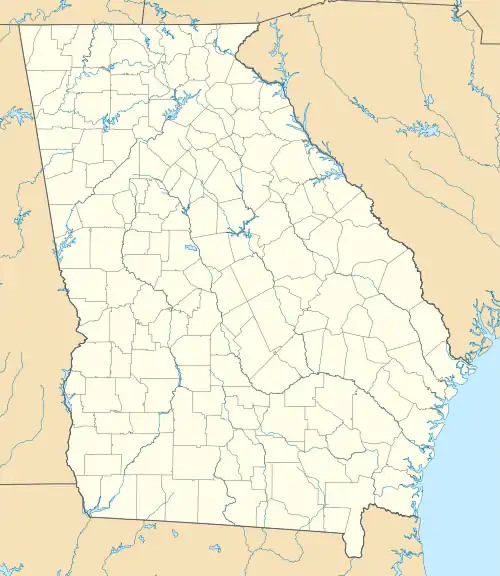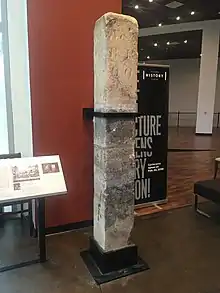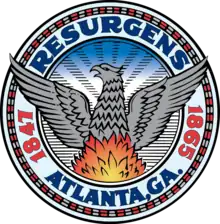Atlanta Zero Mile Post
The Atlanta Zero Mile Post is a stone marker which marked the terminus of the Western and Atlantic Railroad in Atlanta. It was located in a disused building in Downtown Atlanta, within the Underground Atlanta Historic District, under the Central Ave. viaduct, between Alabama and Wall streets.[2][3] The Zero Mile Post was recognized with a historical marker by the Georgia Historical Commission in 1958[4] and entered into the National Register of Historic Places in 1977.[5] It was delisted in 2019.
Western and Atlantic Railroad Zero Milepost | |
Formerly listed on the U.S. National Register of Historic Places | |
 Atlanta Zero Mile Post | |
 | |
| Location | Central Ave. between Wall St. and Railroad Ave., Atlanta, Georgia |
|---|---|
| Area | less than one acre |
| Built | 1842 |
| NRHP reference No. | 77000435[1] |
| Significant dates | |
| Added to NRHP | September 19, 1977 |
| Removed from NRHP | April 26, 2019 |
In the 1980's, the Zero Mile Post was placed indoors as a passenger depot for the New Georgia Railroad tourist operation was constructed around it. After the New Georgia Railroad ceased operation in 1994, the former station was secured behind a locked fence, and would only be accessible by appointments approved by the Georgia Building Authority.

In October 2018, the Zero Mile Post was carefully and successfully removed from the Georgia Building Authority's depot building, with the former being moved to the Atlanta History Center and the latter demolished to accommodate the reconstruction of the Central Avenue and Courtland Street bridges above. A replica post was placed in the exact GPS coordinates of the original's location and paired with an interpretive marker provided by The Georgia Historical Society after the bridgework concluded.
The Zero Mile Post's relocation generated controversy, with some arguing that it lost much of its significance by being removed from its original location,[6] while those at the history center assure that it is well preserved and that the replica is better suited for outdoor exhibition.[7] The Zero Mile Post is currently displayed and interpreted in an exhibition, Locomotion: Railroads and the Making of Atlanta, with the recently restored Texas locomotive, one of the two remaining Western & Atlantic locomotives that would have passed by that very mile post scores of times during its service.
Usually placed along rail lines at each mile, markers informed train crews where they were along a specific route. The above-ground portion of the rectangular marker measures approximately 1 foot wide on each side and 42 inches tall. The crown is pyramidal, and one side the marker is engraved with "W&A RR OO" – the W & A indicating the Western & Atlantic Railroad and the double-zero designating the beginning of the rail line. The other side of the marker is engraved “W&A RR 138”. When entirely exposed, the marker measures 7 feet 5 inches, and weighs approximately 800 pounds.
External links
- Jackie, Goldstein. "In search of Atlanta's Zero Mile Post". Curbed Atlanta. Retrieved 8 August 2016.
- Zero Mile Post historical marker
References
- "National Register Information System". National Register of Historic Places. National Park Service. November 2, 2013.
- "Western & Atlanta Railroad Zero Milepost", Atlanta: a National Register of Historic Places Travel Itinerary, National Park Service
- "ACTUAL FACTUAL GEORGIA: Zero Mile Post marks city's start", June 13, 2016, Atlanta Journal-Constitution
- "Zero Mile Post". Georgia Historical Society. Georgia Historical Society. Retrieved 24 April 2018.
- "Western and Atlantic Railroad Zero Milepost". National Register Digital Assets. National Park Service. Retrieved 24 April 2018.
- “Atlanta’s Zero Milepost Belongs at Atlanta’s Zero Mile Mark.” SaportaReport, 5 Nov. 2018, saportareport.com/atlantas-zero-milepost-belongs-at-atlantas-zero-mile-mark/. Accessed 12 Nov. 2020.
- April 27, Trains Staff |, and 2018. “Atlanta’s Zero Milepost Could Move | Trains Magazine.” TrainsMag.com, trn.trains.com/news/news-wire/2018/04/27-atlantas-zero-milepost-could-move. Accessed 12 Nov. 2020.
